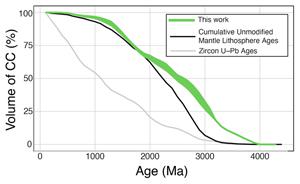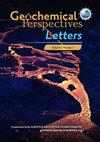大陆生长的岩石圈整体观
IF 3.7
1区 地球科学
Q1 GEOCHEMISTRY & GEOPHYSICS
引用次数: 1
摘要
方法Dhuime等人(2012;2017)计算的先前地壳生长估计在此统称为D27,这些广泛使用的地壳生长曲线是基于Belusova等人(2010)计算的修正。在D27使用的计算方案中,通过汇编锆石Hfisotope贫化地幔模型提取年龄获得了年龄谱。使用每个单独的锆石U-Pb+Hf同位素数据点来计算贫化地幔模型提取年龄,并在地质时间内对这些模型年龄进行装箱。通过对Belousova等人(2010)采用的方法进行修改,对该年龄分布进行了修正。D27没有只考虑锆石Hf同位素数据,而是使用锆石O同位素数据来识别锆石记录中的地壳改造信号,其中地幔范围以上的锆石氧同位素值被认为是改造信号的证据。通过确定地壳改造(使用锆石Hf同位素模型年龄确定)和新生地壳生长(使用O同位素比率确定)之间的关系,计算出了一条被认为是地壳生长率的曲线。补充表S-2中重复了这些计算。然而,D27工作中使用的计算存在缺陷(如(Korenaga,2018)所指出的)。本文章由计算机程序翻译,如有差异,请以英文原文为准。

A whole-lithosphere view of continental growth
Methods Previous Crustal Growth Estimates Previous crustal growth estimates calculated by Dhuime et al., (2012; 2017) are here collectively referred to as D27 and these widely used crustal growth curves are based on a modification of the calculations of Belusova et al. (2010). In the calculation scheme used by D27, an age spectrum was obtained by compiling zircon Hfisotope depleted mantle model extraction ages. Each individual zircon U-Pb + Hf isotope data point was used to calculate a depleted mantle model extraction age, and these model ages were binned across geologic time. This age distribution was corrected for reworking using a modification of the methods employed by (Belousova et al., 2010). Instead of considering only zircon Hf isotope data, D27 used zircon O-isotope data to identify crustal reworking signals in the zircon record where zircon oxygen isotope values above the mantle range were considered to be evidence of a reworking signal. A curve proposed to be the crustal growth rate was calculated by determining the relationship between crustal reworking – identified using zircon Hf isotope model ages – and juvenile crustal growth – identified using O-isotope ratios. These calculations are replicated in Supplementary Table S-2. However, there is a flaw in the calculations employed in the D27 work (as pointed out by (Korenaga, 2018)).
求助全文
通过发布文献求助,成功后即可免费获取论文全文。
去求助
来源期刊

Geochemical Perspectives Letters
Earth and Planetary Sciences-Geochemistry and Petrology
CiteScore
7.00
自引率
2.00%
发文量
42
审稿时长
15 weeks
期刊介绍:
Geochemical Perspectives Letters is an open access, internationally peer-reviewed journal of the European Association of Geochemistry (EAG) that publishes short, highest-quality articles spanning geochemical sciences. The journal aims at rapid publication of the most novel research in geochemistry with a focus on outstanding quality, international importance, originality, and stimulating new developments across the vast array of geochemical disciplines.
 求助内容:
求助内容: 应助结果提醒方式:
应助结果提醒方式:


